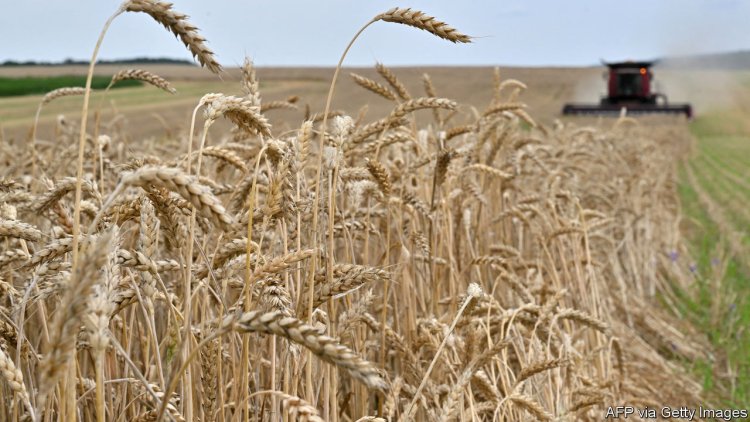Why Russia’s bombings of Ukrainian ports have jolted wheat prices
image: AFP via Getty ImagesAFTER THREE nights of Russian attacks, Ukraine’s ports are counting the cost. The latest bombing, which targeted the Black Sea hub of Odessa and nearby Mykolaiv early on July 20th, left at least two dead and more than 20 injured. Some 60,000 tonnes of grain have been burnt; piers and terminals have also been hit. Kernel, Ukraine’s largest producer of sunflower, said damage at its grain storage and handling infrastructure could take a year to fix.For the rest of the world, a colder gauge also looks troubling. The price of wheat futures in Chicago, the global benchmark, has risen by 11% since the early hours of July 17th, when Russia said it would not renew a year-old deal allowing ships carrying Ukrainian food exports to cross the Black Sea. That seemed to have been priced in. Complaining that Western sanctions throttled its own food exports, Russia had been dragging its feet on letting vessels through for months; Ukraine’s grain shipments had fallen by nearly


AFTER THREE nights of Russian attacks, Ukraine’s ports are counting the cost. The latest bombing, which targeted the Black Sea hub of Odessa and nearby Mykolaiv early on July 20th, left at least two dead and more than 20 injured. Some 60,000 tonnes of grain have been burnt; piers and terminals have also been hit. Kernel, Ukraine’s largest producer of sunflower, said damage at its grain storage and handling infrastructure could take a year to fix.
For the rest of the world, a colder gauge also looks troubling. The price of wheat futures in Chicago, the global benchmark, has risen by 11% since the early hours of July 17th, when Russia said it would not renew a year-old deal allowing ships carrying Ukrainian food exports to cross the Black Sea. That seemed to have been priced in. Complaining that Western sanctions throttled its own food exports, Russia had been dragging its feet on letting vessels through for months; Ukraine’s grain shipments had fallen by nearly half between March and June. But the missile strikes appear to have jolted markets out of their torpor. Are they right to fret?
The sudden reaction is partly rooted in disappointment. Over the 12 months of its existence, the deal had allowed some 33m tonnes of Ukrainian grain and oilseeds to flow out, helping to stave off a global food crisis. This helped bring wheat prices, which had surged to $12 a bushel in March 2022, down by more than a third; they fell to $5.91 a bushel, their lowest in nearly two and a half years, in May. Some had hoped that Ukraine would continue to export through the Black Sea, either with the help of the Turkish navy or by providing commercial shippers with war-risk insurance, says Joe Glauber of IFPRI, a think-tank. Russia’s latest strikes, and its announcement on July 19th that it would treat all ships bound for Ukraine’s Black Sea ports as military threats, have put paid to such optimism.
Ukraine can still export some grain. Since the start of the war it and its allies have worked hard to expand transport alternatives to the Black Sea. Land and river routes via Europe are now able to ferry up to 3.5m tonnes a month; in June they accounted for 3m of the 5m tonnes Ukraine exported overall. But they cannot fully substitute for seaborne trade and they are more expensive. They also risk inflaming tensions between Ukraine and its eastern European neighbours, who claim a grain glut has sent prices crashing in their domestic markets. On July 19th Poland and four other EU countries asked the European Commission to continue restricting imports of Ukrainian grain (it first did so in May). America’s Department of Agriculture estimates that Ukraine’s combined exports of maize and wheat will reach 30m tonnes this season, a third less than in 2021-22.
Ukraine typically accounts for 10% of global wheat exports and 10-15% of maize exports. The loss of a sizeable chunk of its supplies is therefore significant. But it is not yet a disaster. Extraordinarily strong wheat exports from Australia and Russia last season mean the global larder is not bare. Canada’s wheat shipments are rebounding after crippling droughts in recent years. American and European crops look set to beat those of 2022. Any shortfall in Ukrainian maize is likely to be plugged by record output from Brazil. International trade in both grains is projected at near-record levels in 2023-24. Despite the latest rises, prices for both remain at pre-war levels.
Russia’s blockade of Ukraine, however, will further concentrate supply among a few major exporters. That is particularly true of maize, where Brazil has gone from being a minor supplier before 2000 to being expected to account for more than 30% of global exports in 2022-23, notes Alexis Ellender of Kpler, a data firm. But it also applies to wheat, where the top five exporters—America, Australia, Canada, the EU and Russia—have a combined market share of 70%.
Greater concentration of supply makes the market more vulnerable to a further shock. That looks all too possible. Dry weather is already causing downward revisions to output in Argentina, Canada and the EU; heat is also threatening America’s Midwest. Granted, lower exports from these places may be partly compensated for by greater shipments from Russia, whose wheat-export market share could reach 22% this season. But that is not particularly reassuring. Shunned by Western traders, the Russian wheat trade, though not under sanctions, has become the domain of shady middlemen. These have access to fewer ships; insurance is either unavailable or dear. On July 20th Ukraine in turn said it would treat any Russian vessels as targets, making that trade even more fraught. Russia itself could decide to increase export taxes on wheat to finance its military campaign in Ukraine, throttling shipments.
Meanwhile, demand for grain is expected to rise. America appears to be skirting a recession, which will maintain demand for corn-made biofuels. China’s imports of agricultural foodstuff are rebounding. Global wheat inventories are projected to fall this year, for the fourth time in a row. Stocks-to-use ratios could drop to 20%; those of large exporters, which matter most to global prices, will fall even lower.
The market’s security buffers are thus likely to dwindle, making a catastrophe likelier in the medium term. It’s unclear when they will recover. More expensive and feebler export routes will discourage Ukrainian farmers from planting, meaning their exports could be permanently curtailed. Analysts at JPMorgan Chase project they could fall to half their normal levels in 2023-24. Russia’s bombings have not yet set the world’s wheat markets ablaze. But they have made them much more flammable. ■
Correction (July 21st 2023): This article originally overstated wheat prices by a factor of 100. We’ve now adjusted our decimal places. Sorry.
What's Your Reaction?













